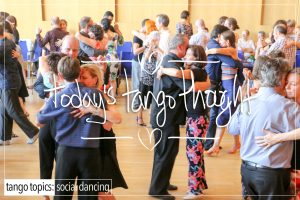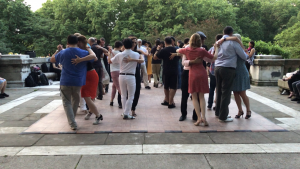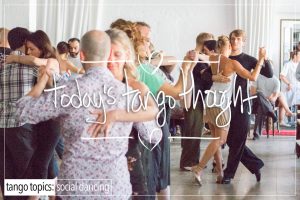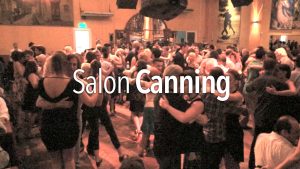At some point along the curve of your tango life, continuing to take classes seems like a really stupid idea. You’ve learned everything you need to know to get around the floor. Practice isn’t really that important any longer. And going to Milongas is really the important part, so who needs to go to ‘class’ ? It’s entirely possible that you feel like you’ve outgrown your teachers. They couldn’t possibly have anything else of value to share with you. Besides continuing with classes is the same people, or they’re all ‘beginners’, and you’re so not a beginner any more. You’ve got this, right ? Seriously, who needs to know 47 Ganchos, 24 Volcadas, and how many ways are there to walk and honestly, who the frak cares ? And then there’s that whole business of the 1-2-3 thing in vals, totally unimportant. Right ?
Nope. Nothing to see here. Move along. Classes ? So passé!
Nothing could be further from the truth than line of egotistical claptrap above. Put simply, tango is an insanely rich and dense dance that takes years, if not decades, to get to a point that it starts to work effortlessly. This is not something you pick up in 5 minutes of a class. It’s just not. The walk itself takes a decade or three to get anywhere close to an idea approaching ‘desirable’, not ‘right’ but desirable. One’s embrace, there’s a lifetime of work involved in that pursuit alone. As there are sooooo many places where it can go ‘wrong’, and is often the source of so much blame (when it fact it’s actually more than likely your walk that’s all screwed up).
Tete Rusconi, the man responsible for a revitalization of close embrace dancing in the modern tango era, whose ideas became the bedrock for what most people teach today. This was due in a large part to his student Daniel Trenner who started ‘Bridge To The Tango’ videos which he shot with Rebecca Shulman in the late 80’s and early 90’s, and by Eric Jorissen from the Netherlands, both went on to teach thousands of students, and those students in turn taught thousands more. All from one guy. Tete Rusconi was asked once, “Maestro ? What are you working on ?”, and his response was exceptionally telling. Mind you when he said this he was 83. He’d been dancing since he was 11 years old, for 72 years. He responded with “…Mi Caminta!”. Which translates to English as “My walk!”. You would expect this guy to answer that question with some kind of crazy figure description, or some elaborate or intricate step or pattern. Nope. He answered with the one thing that he knew to be true: The walk is everything! Fix that, change that, and your dance changes in more ways than you can count. Make that walk effortless, clean, clear, easeful and you’re on to something. Put another way, if his answer was “…Mi caminata” after 72 years of dancing, what on god’s green earth makes you believe that after 5 minutes of class or a year or two of dancing that you got this ? In short, arrogance is what makes you believe that. So, ‘no’, you don’t got this!
In other words: Go back to class and start re-educating yourself, constantly.
At some point along the curve of your tango life, continuing to take classes seems like a really stupid idea. You’ve learned everything you need to know to get around the floor. Practice isn’t really that important any longer. And going to Milongas is really the important part, so who needs to go to ‘class’ ? It’s entirely possible that you feel like you’ve outgrown your teachers. They couldn’t possibly have anything else of value to share with you. Besides continuing with classes is the same people, or they’re all ‘beginners’, and you’re so not a beginner any more. You’ve got this, right ? Seriously, who needs to know 47 Ganchos, 24 Volcadas, and how many ways are there to walk and honestly, who the frak cares ? And then there’s that whole business of the 1-2-3 thing in vals, totally unimportant. Right ?
Nope. Nothing to see here. Move along. Classes ? So passé!
Nothing could be further from the truth than line of egotistical claptrap above. Put simply, tango is an insanely rich and dense dance that takes years, if not decades, to get to a point that it starts to work effortlessly. This is not something you pick up in 5 minutes of a class. It’s just not. The walk itself takes a decade or three to get anywhere close to an idea approaching ‘desirable’, not ‘right’ but desirable. One’s embrace, there’s a lifetime of work involved in that pursuit alone. As there are sooooo many places where it can go ‘wrong’, and is often the source of so much blame (when it fact it’s actually more than likely your walk that’s all screwed up).
Tete Rusconi, the man responsible for a revitalization of close embrace dancing in the modern tango era, whose ideas became the bedrock for what most people teach today. This was due in a large part to his student Daniel Trenner who started ‘Bridge To The Tango’ videos which he shot with Rebecca Shulman in the late 80’s and early 90’s, and by Eric Jorissen from the Netherlands, both went on to teach thousands of students, and those students in turn taught thousands more. All from one guy. Tete Rusconi was asked once, “Maestro ? What are you working on ?”, and his response was exceptionally telling. Mind you when he said this he was 83. He’d been dancing since he was 11 years old, for 72 years. He responded with “…Mi Caminta!”. Which translates to English as “My walk!”. You would expect this guy to answer that question with some kind of crazy figure description, or some elaborate or intricate step or pattern. Nope. He answered with the one thing that he knew to be true: The walk is everything! Fix that, change that, and your dance changes in more ways than you can count. Make that walk effortless, clean, clear, easeful and you’re on to something. Put another way, if his answer was “…Mi caminata” after 72 years of dancing, what on god’s green earth makes you believe that after 5 minutes of class or a year or two of dancing that you got this ? In short, arrogance is what makes you believe that. So, ‘no’, you don’t got this!
In other words: Go back to class and start re-educating yourself, constantly.











